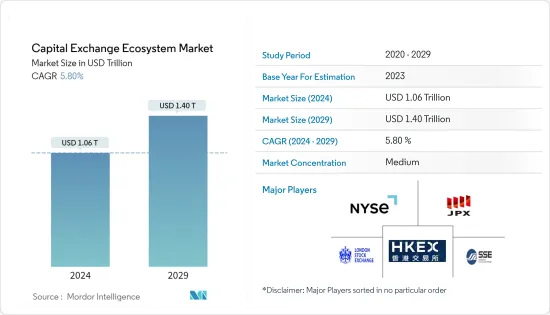PUBLISHER: Mordor Intelligence | PRODUCT CODE: 1431564

PUBLISHER: Mordor Intelligence | PRODUCT CODE: 1431564
Capital Exchange Ecosystem - Market Share Analysis, Industry Trends & Statistics, Growth Forecasts (2024 - 2029)
The Capital Exchange Ecosystem Market size is estimated at USD 1.06 trillion in 2024, and is expected to reach USD 1.40 trillion by 2029, growing at a CAGR of 5.80% during the forecast period (2024-2029).

Capital Market exchanges are developed to satisfy the need to raise funds for individuals, firms and governments. The fund is generally raised through trading of funding instruments such as shares, debentures, debt instruments, bonds, ETFs, etc. Capital markets are established in stock exchanges such as the equity, debt, and options markets. Investors invest money in a firm's share or bond, bridging the gap between suppliers of capital and people in need of money. With market risk in shares and mutual funds, risk occurs over one's investment and hinders income.
With the advent of COVID-19 in early 2020 and major lockdowns being placed in major economy stock exchange market index observed continuous fluctuations with people investing money for small gains at the retail level.
Returns and dividends of stocks provided by companies observed continuous growth during COVID-19, with companies doing a large layoff during COVID-19 and increasing their market value by releasing more stocks. After COVID-19, the economy started normalizing, and an increase in inflation combined with contractionary monetary policy caused a slowdown in growth and a reduction in dividends.
Capital Exchange Ecosystem Market Trends
Increasing Stock Exchanges Index affecting Capital Market Exchange Ecosystem
With the advent of the COVID-19 index value of major stock exchanges declined globally. For NYSE (New York Stock Exchange), on November 2019, the index value stood at 2,447.01, continuously declining with lockdowns and economic restrictions, reaching 1,536.99 on March 2020. After 2020 with a change in the market scenario and further speculations, stock Index value increased. Similarity Dow Jones Industrial Average observed a similar trend. With this trend, as the stock price declined, people started placing more money in the market with declining stock price. Positive growth was observed as economy options and for meeting global demand loopholes in the supply chain were fixed. With this continuous bubbling, stock price overall major index started to decline after reaching their highest level.
Negative Real Interest rake in Banking affecting Capital Market Exchange Ecosystem.
As global inflation had observed a continuous increase with a decline in the interest rate of banks and accommodative policies, earning through interest rate on deposits had fallen below the rate of inflation; this trend had caused a lot of people to invest in Global Capital Market for achieving a higher level of interest rate.
A significant gap exists between all the countries between inflation rate and central bank interest rate, with the inflation rate leading the bank interest rate except for China. In China, during January 2022 inflation rate exists at 0.9%, with the central bank interest rate at 3.7%, showing a restrive monetary policy opposite to all other nations adopting accommodative monetary policy.
Capital Exchange Ecosystem Industry Overview
As firms increase their capital globally for their investments, they need capital. Issuing shares is the easiest method for firms to raise capital where shareholders' earning depends on an overall company value change. The total number of shares issued in global markets has observed continuous positive growth. With this increase in share issue trend value of equity had also observed growth, creating a positive market for investment and attracting more people to invest and buy company shares.
Additional Benefits:
- The market estimate (ME) sheet in Excel format
- 3 months of analyst support
TABLE OF CONTENTS
1 INTRODUCTION
- 1.1 Study Assumptions and Market Definition
- 1.2 Scope of the Study
2 RESEARCH METHODOLOGY
3 EXECUTIVE SUMMARY
4 MARKET DYNAMICS
- 4.1 Market Overview
- 4.2 Market Drivers
- 4.2.1 Automating all processes
- 4.2.2 Regulatory Landscape
- 4.3 Market Restraints
- 4.3.1 Capital restrictions can slow down growth
- 4.4 Market Opportunities
- 4.4.1 Diversification across the value chain
- 4.5 Porter's Five Forces Analysis
- 4.5.1 Bargaining Power of Buyers/Consumers
- 4.5.2 Bargaining Power of Suppliers
- 4.5.3 Threat of New Entrants
- 4.5.4 Threat of Substitute Products
- 4.5.5 Intensity of Competitive Rivalry
5 MARKET SEGMENTATION
- 5.1 Market Composition
- 5.1.1 Primary
- 5.1.2 Secondary
- 5.2 Capital Market
- 5.2.1 Stocks
- 5.2.2 Bonds
- 5.3 Stock Type
- 5.3.1 Common and Preferred
- 5.3.2 Growth Stock
- 5.3.3 Value Stock
- 5.3.4 Defensive stock
- 5.4 Bond Type
- 5.4.1 Government
- 5.4.2 Corporate
- 5.4.3 Municiple
- 5.4.4 Mortgage
- 5.4.5 Other Bond Types
6 COMPETITIVE LANDSCAPE
- 6.1 Overview (Market Concentration and Major Players)
- 6.2 Company Profiles
- 6.2.1 New York Stock Exchange
- 6.2.2 Japan Exchange Group
- 6.2.3 London Stock Exchange
- 6.2.4 HongKong Stock Exchange
- 6.2.5 Shanghai Stock Exchange
- 6.2.6 National Stock Exchange
- 6.2.7 EURONEXT
- 6.2.8 NASDAQ
- 6.2.9 Bombay Stock Exchange
- 6.2.10 Saudi Stock Exchange*
7 MARKET OPPORTUNITIES AND FUTURE TRENDS
8 DISCLAIMER




